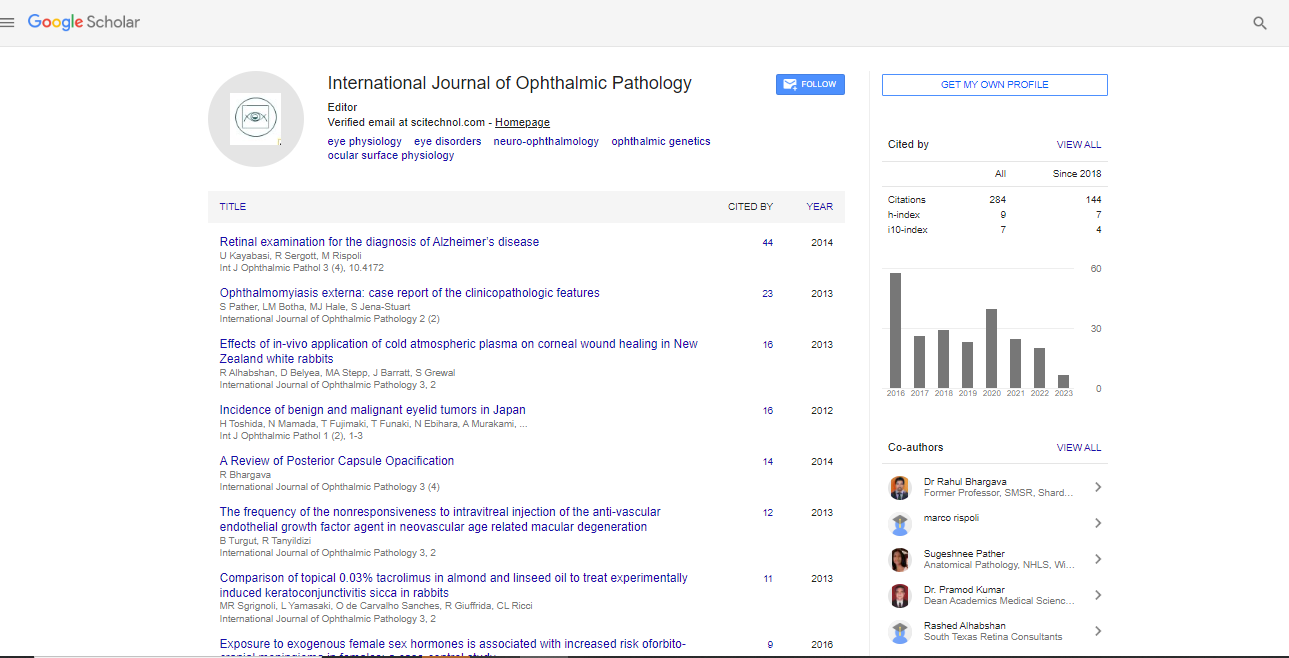Commentary, Vol: 14 Issue: 1
Managing the Ocular Dysplasia Diagnosis and Treatment Approaches
Iorio McCourt*
Department of Ophthalmology, University of Texas Southwestern Medical Center, Texas, United States of America
*Corresponding Author: Iorio McCourt Department of Ophthalmology, University of Texas Southwestern Medical Center, Texas, United States of America, E-mail: ioricourt@utsouthwestern.edu
Received date: 07 April, 2024, Manuscript No. IOPJ-24-131714; Editor assigned date: 09 April, 2024, PreQC No. IOPJ-24-131714 (PQ); Reviewed date: 24 April, 2024, QC No. IOPJ-24-131714; Revised date: 07 February, 2025, Manuscript No. IOPJ-24-131714 (R); Published date: 17 February, 2025, DOI: 10.4172/2324-8599.1000059
Citation: McCourt I (2025) Managing the Ocular Dysplasia Diagnosis and Treatment Approaches. Int J Ophthalmic Pathol 14:1.
Description
Managing ocular dysplasia involves a multifaceted approach that encompasses accurate diagnosis, appropriate treatment strategies and continuous observation to optimize visual outcomes and preserve ocular health. Ocular dysplasia refers to abnormal development or growth of ocular tissues, including the retina, leading to vision impairment and potential complications. This condition can manifest in various forms and severity levels, requiring customized management approaches for each patient. Diagnosis of ocular dysplasia begins with a comprehensive eye examination, including visual acuity testing, fundus examination and imaging studies such as Optical Coherence Tomography (OCT) and fluorescein angiography. These diagnostic modalities help assess the structural integrity of the retina, identify any abnormalities or malformations and determine the extent of vision impairment. Upon confirming a diagnosis of ocular dysplasia, the next step is to establish a treatment plan customized to the individual patient's needs and the specific characteristics of their condition.
Treatment approaches for ocular dysplasia encompass a range of options customized to the individual's specific needs and the severity of the condition. In instances of mild or asymptomatic ocular dysplasia, a conservative strategy of observation and regular monitoring under the guidance of an ophthalmologist may be deemed appropriate. This approach enables the healthcare team to closely track any changes in vision or ocular health over time, ensuring timely intervention if necessary. For individuals experiencing refractive errors associated with ocular dysplasia, such as myopia or astigmatism, optical correction through glasses or contact lenses can significantly enhance visual acuity and alleviate symptoms, thereby improving overall quality of life. In cases where visual impairment persists despite optical correction, low vision aids like magnifiers and telescopes provide valuable support by maximizing remaining vision and enhancing functional abilities, particularly for tasks such as reading, writing and navigating the environment.
Medical management strategies may be employed to address specific symptoms or complications associated with ocular dysplasia. This may involve the use of medications such as topical steroids or anti-VEGF agents to manage inflammation or abnormal blood vessel growth in the retina. In more severe cases where structural abnormalities or complications impact vision, surgical interventions such as retinal detachment repair; vitrectomy or laser photocoagulation may be necessary to stabilize or improve visual function and prevent further vision loss. For individuals with hereditary forms of ocular dysplasia, genetic counseling and testing can provide valuable information regarding the risk of passing the condition on to future generations, guiding family planning decisions. The comprehensive rehabilitation services play a vital role in supporting individuals with significant vision impairment resulting from ocular dysplasia. These services encompass orientation and mobility training, Activities of Daily Living (ADLs) skills training and psychosocial support to promote functional independence and enhance overall quality of life for affected individuals.
Conclusion
In addition to these treatment approaches, ongoing education and support are essential components of managing ocular dysplasia. Patients and their families should receive comprehensive information about the condition, treatment options and available support services. They should also be encouraged to actively participate in the care and advocate for the visual health needs. The multidisciplinary collaboration among healthcare professionals, including ophthalmologists, optometrists, genetic counselors, rehabilitation specialists and social workers, is important for providing comprehensive care to individuals with ocular dysplasia. By addressing both the medical and psychosocial aspects of the condition, healthcare professionals can help patients with ocular dysplasia achieve the best possible visual outcomes and maintain optimal ocular health and well-being.
 Spanish
Spanish  Chinese
Chinese  Russian
Russian  German
German  French
French  Japanese
Japanese  Portuguese
Portuguese  Hindi
Hindi 